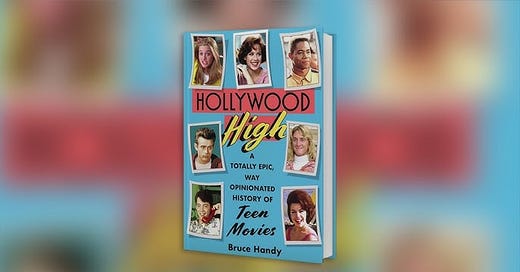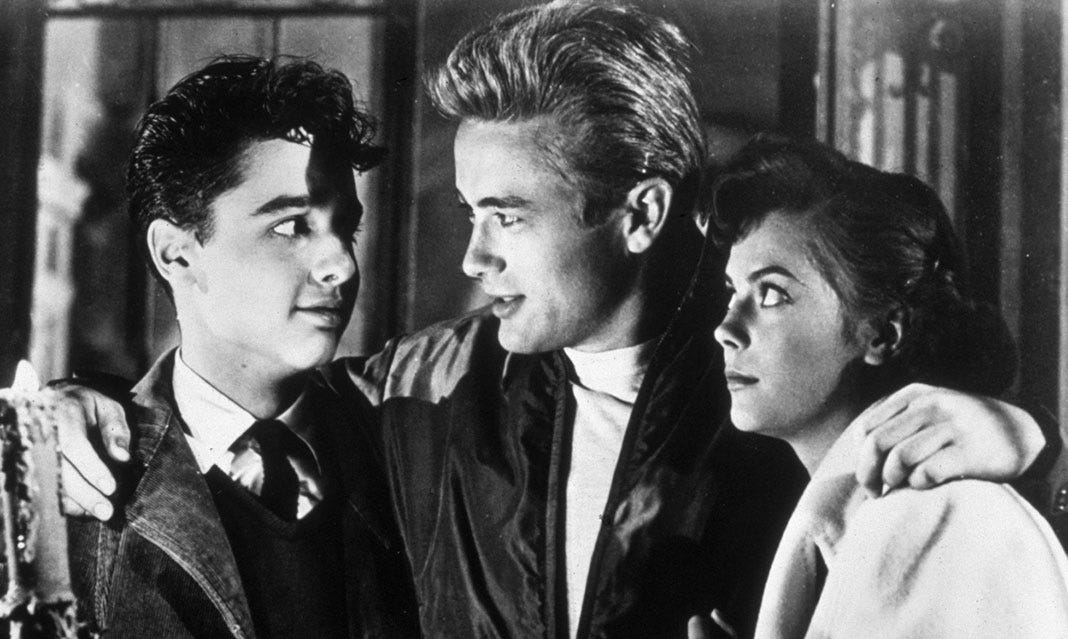A New Book Offers an Old Take on "Rebel"
Journalist Bruce Handy's "Hollywood High" has a disappointingly conventional approach to the quintessential teen movie.
I’ve been under the weather for the past week, since my son brough home influenza B, so I have been far behind schedule in terms of getting though material. I had meant to write a piece about Vanity Fair correspondent Bruce Handy’s new book Hollywood High: A Totally Epic, Way Opinionated History of Teen Movies after it was released on May 20. Well, that didn’t happen, but now I have a few minutes to try to catch up. However, I don’t have the stamina or the energy to talk about the whole of Handy’s book, which was, frankly, a disappointment.
I had expected a rich and insightful look at the evolution of adolescent-themed movies over the past century, but instead I read a grab-bag of loosely themed essays in which Handy focused on whichever film he felt represented a particular decade, with little method behind either the choices or the structure of each chapter. Sometimes, he focuses a chapter on a particular actor, as in the opening chapter on Mickey Rooney’s libido, and other times the focus is on a director, as in his look at Nicholas Ray in the second chapter, or even the writer, as with Tina Fey in the chapter on Mean Girls. It’s maddening to an extent because his thesis about the influence of teen movies on culture is almost wholly divorced from his gossipy look behind the scenes. Mickey Rooney may have been a man-whore, but the teens of the 1940s didn’t know that, and whether he really did get a blow job from an underage Elizabeth Taylor (an anecdote Handy references several times) played no role in the shaping of American culture. (The writing also ranges from eloquent to cringe to confusing; at one point, Handy, who is in his seventies, tells readers who are not familiar with an older movie he is discussing to simply think about “Joe Besser playing Stinky on The Abbott and Costello Show,” a program that went off the air in 1954!)
Anyway, I wanted to spend a few pages talking about Handy’s chapter-length treatment of Rebel without a Cause, for obvious reasons. I found this particular chapter especially disappointing. When I began writing what turned into Jimmy: The Secret Life of James Dean, I originally conceived of framing a study of Rebel without a Cause around Nicholas Ray but quickly decided against it because Ray was a somewhat grotesque person, and I didn’t want to have to make apologies for his bad behavior. Not so Handy, whose only concern about Ray’s statutory rape of an underage Natalie Wood is that it wasn’t “age appropriate” for Wood.
No matter. There are bigger problems. Handy models his chapter on the 2005 history Live Fast, Die Young: The Wild Ride of Making Rebel without a Cause by Al Weisel and Larry Frascella, from whom he lifts nearly the entire set of facts and, I am pretty sure, nearly all of the quotations (he doesn’t use notes but mentions the book repeated in the text). As a result, he asserts with confidence that Dean almost didn’t make the movie because he got cold feet and fled to New York before shooting started. As my readers know, that’s not true; although Handy wouldn’t have known, my book explains with documentary proof that Dean actually flew to New York to sign settlement documents to forestall a lawsuit his former boyfriend had threatened in an attempt to extort money from the newly famous Dean—a lawsuit that would have revealed their same-sex relationship and ended Dean’s career.
And yet, despite having clearly used Live Fast as his source and distilled it down to a chapter, Handy somehow downplays most of the conclusions that Weisel and Frascella drew back in 2005 while presenting a more conventional narrative as though it were the authors’. Live Fast was admirably frank about how queer Rebel without a Cause was, but Handy has a different agenda.
Handy sees Rebel without a Cause as a story about a teenage crime spree and the forces driving young people to delinquency. This, of course, is how Warner Bros. publicity department advertised the film, based on early scripts—Handy quotes 1955 ads WB put out depicting James Dean’s character as a violent delinquent and gang member—but it really doesn’t match the finished film. In Handy’s telling, the film’s fulcrum is Natalie Wood’s deep and intense, if mercurial, love for first Buzz and then Jim. As for Sal Mineo’s Plato, Handy dutifully reports what Weisel and Fracsella said and then completely ignores it for the rest of the chapter:
Dean was bisexual, and though no one has claimed he and Mineo had a physical relationship, they did grow close, paralleling the friendship between Plato and Jim, with its strong sexual undercurrents. At one point in the shooting, Dean even told Mineo to “look at me the way I look at Natalie,” and the younger actor later described his collaboration with Dean in terms of sexual awakening…
Indeed, Handy is quick to minimize the idea that Plato is intended as a gay character—despite the fact that screenwriter Stewart Stern literally and repeatedly said he wrote him to be gay. Instead, Handy wants us to reinterpret even the most blatant hints in a much blander way:
At school, we see Plato at his locker, inside of which he’s taped a picture of Alan Ladd in what appears to be a publicity shot from Shane, released two years earlier. This bit of set decoration has been widely interpreted as a hint to savvy audiences that Plato is gay, reinforced by the fact that while he’s combing his hair in a small mirror above the Ladd photo, he sees Jim, who he stares after with a look that very definitely conveys, per Mineo’s later words, that “something was happening.” But the picture of Ladd as Shane is also a sign of Plato’s yearning for a father figure, and a token of the western themes that infuse Rebel Without a Cause…
Throughout the chapter, Handy takes a surprisingly literal reading of Rebel, emphasizing the three main characters’ desire for a strong father figure and ignoring any psychosexual implications. (I say literal because in the film, all three characters explicitly remark on the idea that Plato is treating Jim as a surrogate father, and such lampshading is generally a good indication that something more is going on beneath the surface.)
Handy also makes no effort to explain why Plato’s death is, in his words, a “tragedy.” He comes close to drawing the obvious conclusion, but instead leaves these lines to dangle unanalyzed:
Dean gets his last big moment, weeping convulsively over Plato, who is still wearing Jim’s red windbreaker, then laughing sadly when he notices Plato’s mismatched socks. In the moment, the performance was so wrenching that Mineo would later claim, “In Plato’s death scene, I understood what being loved meant… I wanted to do that scene over and over.”
So, Bruce, why do you think Jim was so broken up about Plato dying? The trouble is that Handy’s thesis is that Jim Stark is “an American hero,” and as we all know, American heroes have to be robustly heterosexual. He therefore lets sit in benign neglect the otherwise inexplicable notion that Jim Stark’s biggest display of emotion in Rebel is theatrically mourning over a dead boy who is literally wearing Jim’s clothes.





